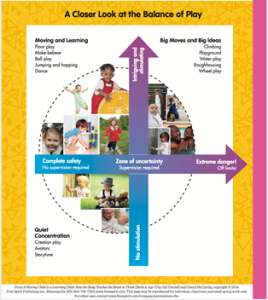The Balance of Play
by Danielle Carter, MS OTR/L
When children play, part of their exploration is pushing limits. We all know those busy toddlers or active kids who seem to be lured by challenges and risks as they interact and explore their world. As parents, it is our natural inclination to protect our children from potential danger and intervene. But part of protecting them is allowing them freedom to explore, and this type of play helps them learn where their bodies are in space, build resilience and self-confidence, and develop essential problem solving skills.
Occupational Therapists are trained in how to break down an activity to match a child’s current skills and find a “just right” challenge. The “just right” challenge is that space where the most learning happens by allowing a child to build on his/her strengths, without becoming overly frustrated and discouraged. Play that provides this kind of challenge is generally fun for the child. An added benefit of this is that their muscles are learning new motor plans sending new messages to their brains to form new neural pathways. This “just right” challenge is where new learning happens.
Gill Connell and Cheryl McCarthy talk about the balance of play in their book “A Moving Child is a Learning Child”, a wonderful book for parents looking to learn more about how movement affects learning. The book discusses the “Zone of Uncertainty” as the space between complete safety (where a child can play independently without supervision) and extreme danger (which is totally off limits). In the zone of uncertainty, supervision is required as kids learn to test limits and push boundaries. It is in this space where the most learning happens.
As parents, we can enter their play and teach our children to manage risk. Connell and McCarthy offer a pause, prompt, praise system of finding the balance of play and helping children manage risk. When a child is playing, remember you know your child well. It is helpful to pause and ask yourself “Is this an immediate danger”. If the answer is no, pause and give your child time to work it out. If you feel the need to step in for safety, then do so. But consider giving your child a prompt such as “I see that your leg is stuck in the tunnel. I wonder how we can get it out”. This allows your child a moment to problem solve and empowers her to figure it out. Finally praise your child for her solutions and be specific. Instead of “good job getting unstuck” you could offer “I like the way you held my hand while you lifted your knee”. This type of feedback gives her information that she can use in the future to solve a similar problem.
In this example the child learned confidence, gained information about where her body was in space, learned about gravity and balance, and developed problem solving skills. Had we prevented the child from exploring because we deemed it too risky or unsafe, or had we solved the problem for her by moving her leg ourselves, we would have robbed her brain and body of valuable learning.
I challenge you to think about this pause, prompt, praise method the next time your child Is playing in a way you deem risky. Pause and think is this truly a dangerous situation? Do you need to intervene right now or just stay close? Is there a way that you can prompt your child to problem solve the situation? Can you praise/provide feedback in a specific way to add depth to her learning?
Then praise yourself for allowing your child to test limits and explore. You are allowing her time in the zone of uncertainty which is the space where the most learning occurs.

